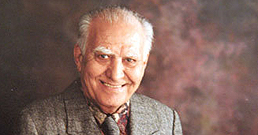A collection of photographs of Tehran, taken between 1941 and 2001 by the late Mahmoud Pakzad, was recently exhibited in Tehran. Born in 1924, he began his career in photography as an apprentice in his teenage years as a result of a decision taken by his mother. His grandmother was a lady-in-waiting in the Court, and initially his mother wanted him to enter the Court, albeit as a barber. But the death of his father and the loss of the family fortune made her change her mind, and she sent him instead to a photographer to learn a skill with a better prospect of earning money.
Soon he became fascinated by the magic of the camera, but it was the artistic aspect of photography rather than the opportunity of making money that interested him most. He saved months of his salary to buy a very expensive camera, and later he paid to learn the technique of developing and printing negatives. This was not easy as in those days the few existing professional photographers jealously guarded the secrets of their trade for the fear of having rivals.
Armed with the latest camera and the necessary technical knowledge, the young Mahmoud would go around the city, capturing images of everyday life as well as urban sites such as buildings, roads, shops, cinemas, the bazaar, etc. Little did he know that several decades later these ordinary photographs of the daily life of his fellow citizens and the fabric of their city would provide such a unique portrayal of a bygone age.
He went on to set up several studios which thrived until early 1980s when the business began to decline. It was at this point that Mahmoud Pakzad remembered his old photographs, a valuable asset the publication of which brought him another round of success and sustained him throughout the rest of his days. He dedicated his ‘Old Tehran’ album of photographs to his mother in recognition of her role in changing the course of his life.
This multimedia report takes us back to the sites and scenes of old Tehran through the remarkable photographs of Mahmoud Pakzad, whilst his daughter, Behnaz, gives us an insight into her father’s life and times and how this collection came to be compiled.


